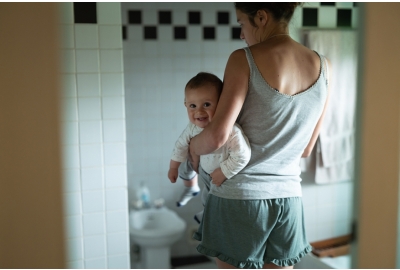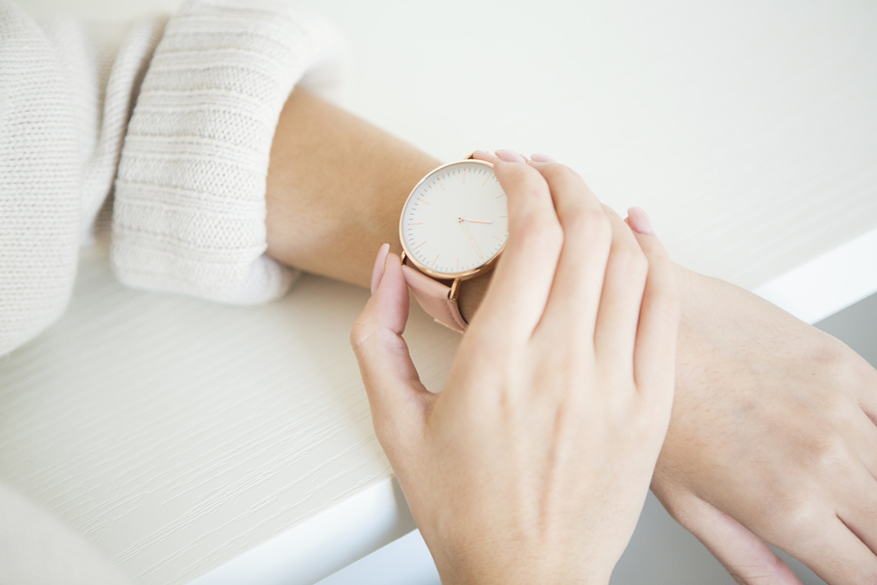
6 Tips to Better Manage Postpartum Incontinence

By HQuality / Shutterstock.com
You may have gotten through the pregnancy and gave birth, but the process isn’t necessarily over yet. Many women find themselves experiencing postpartum incontinence, aka non-voluntary urine leakage. Postpartum incontinence is actually a pretty common side effect, and many women experience it in the weeks after giving birth. If you’re dealing with post-pregnancy urine leakage, here are six things you can do to manage it, from wearing Poise liners to changing your diet:
Shop All Incontinence Products for Women
1. Wear Bladder Leakage Pads
Incontinence liners look a bit like large maxi pads and are much more discreet than adult diapers. They are comfortable to wear and easy to change out when they become saturated, plus they allow you to continue to wear your regular underwear. Bladder leakage pads are a fantastic way to stay dry and comfortable in the short-term while you wait for your body to heal. Just about everyone leaks for a little while after pregnancy, so accept that it’s happening and use incontinence products for women to make yourself comfortable in the meantime. Just remember, don’t wear tampons, which won’t stop urine leakage — that comes out of a different hole than menstrual blood — and also aren’t cleared for postpartum wear either.
2. Try Kegel Exercises
Once your muscles have healed enough to permit targeted activity, your doctor may recommend that you start with pelvic floor therapy, in particular, Kegel exercises. These exercises require tightening the pelvic floor muscles, aka the very same muscles that get stretched out during childbirth. These muscles can be difficult to contract if you’ve never done Kegels before (a lot of people accidentally tense their abdominals instead), so your doctor might recommend inserting a Kegel ball into your vagina to help you identify the right muscles. You can increase the intensity of the Kegel ball exercises when you are ready by adding extra weights or more balls.
Kegel Ball Exercises: How to Use Kegel Balls

By Connor Evans / Shutterstock.com
3. Start Bladder Training
If you continue to experience incontinence even after your body initially recovers, then your doctor will likely recommend some type of bladder training to see if that rectifies the problem. Bladder training can take several different approaches. In one approach, you might try using the restroom every 60 minutes, then every 75 minutes the following week, then every 90 minutes the week after that, and so on until you can hold it for several hours. If you struggle with the sudden and overwhelming urge to urinate, your doctor might have you wait it out for 15 minutes, then 30 minutes, and so on until the urges go away.
Learn More About Bladder Training
4. Make Dietary Changes
Certain foods and beverages can make you pee more and thus contribute to incontinence. Avoid irritating foods such as citrus, tomatoes, and spicy foods, as well as beverages such as caffeine, soft drinks, and alcohol. Constipation can also worsen incontinence by putting pressure on the muscles down there, so if you know that certain foods cause you to get backed up, then try to avoid them postpartum as much as possible. You may want to keep a food diary so you can track which foods worsen your incontinence and/or constipation.
Discover How to Calm an Irritated Bladder

By fizkes / Shutterstock.com
5. Consider Medications
If your incontinence persists even with bladder training, then your doctor will likely recommend some medications to relieve your symptoms. Your doctor will work with you to identify the cause(s) of your incontinence and prescribe medications to address it. Examples of medications prescribed for incontinence include oxybutynin (Ditropan XL), tolterodine (Detrol), darifenacin (Enablex), fesoterodine (Toviaz), solifenacin (Vesicare), trospium (Sanctura), and mirabegron (Myrbetriq).
6. Use a Pessary
A pessary is a prosthetic device that can be inserted into the vagina in order to support the correct internal structures of the pelvic muscles and organs. A pessary is used in the case of prolapse, which occurs when an organ slips out of its correct place. Prolapse can put pressure on the bladder, contributing to incontinence. Pregnancy and giving birth can cause prolapse in the pelvic regions due to all the strain that the area is under. Your doctor will help you determine the right kind of pessary for your body and needs and train you on how to insert and remove it correctly.
What Are The Signs of a Prolapsed Bladder?
In cases of extreme incontinence, your doctor might recommend interventional therapies or surgery. However, in many cases, postpartum incontinence can be addressed using the less invasive methods outlined here. If you are experiencing incontinence, make sure to talk about it with your doctor, and they will help devise a course of treatment for your needs. And if you’re in need of incontinence products for women, be sure to shop our selection of pads and liners. We ship them discreetly straight to your door so you don’t even need to leave the house to get them.